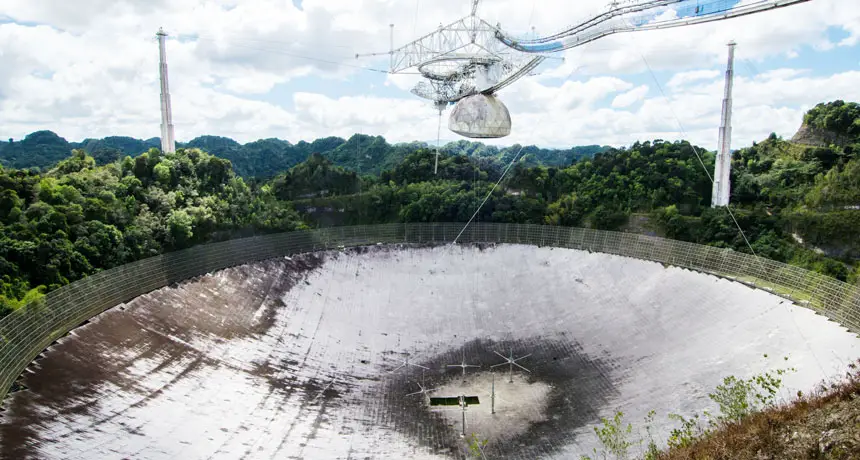For many years, the Arecibo Observatory has been an indispensable component of the investigation carried out in the field of radio astronomy, making it a historical symbol in the field. In spite of this, after suffering substantial setbacks as a result of Hurricane Maria in 2017, it was determined that it would be unsafe to repair the enormous radio dish, which led to its eventual collapse in December of 2020. In the wake of this terrible incident, the National Science Foundation (NSF) has just lately made public its intentions to transform the location. The National Science Foundation (NSF) has proposed repurposing the Arecibo Observatory in Puerto Rico into a cutting-edge science, technology, engineering, and mathematics (STEM) education facility rather than replacing its recognizable radio dish. This article explores the National Science Foundation’s (NSF) vision for the future of the observatory and outlines the essential features of this new educational effort.
A Move Towards Education in the STEM Fields
Some people were taken aback when they learned that the National Science Foundation (NSF) had decided not to rebuild the radio dish at the Arecibo Observatory, which had been an essential component of scientific study. Instead, the National Science Foundation plans to repurpose the property so that it can serve as a hub for teaching and outreach in the STEM fields. The purpose of the proposed educational center is to expand on the various outreach activities that are already in place while also offering novel STEM programs that will engage students and the larger community. The National Science Foundation (NSF) plans to encourage future generations of scientists, engineers, and innovators in Puerto Rico and abroad by shifting its emphasis from research to education.
A Method That Draws From Numerous Disciplines
According to the request for proposals that was distributed by the NSF, the new educational center will take an interdisciplinary approach to its operations. This indicates that the center will not be restricted to the scientific fields of astronomy or astrophysics alone, but rather will encompass a wide range of scientific fields. Students will be encouraged to explore multiple areas of interest and discover their passions within the scientific realm thanks to the center’s incorporation of a varied variety of STEM topics, which will help to develop a holistic learning experience.
Enhancing the Existing Programs in Education and Community Outreach
The Arecibo Observatory was responsible for a number of educational and community outreach programs in the past; one of the key goals of the proposed STEM education hub is to build upon those programs and make them even more comprehensive. Through the years, these programs have acquainted students, teachers, and members of the general public with the marvels of astronomy and the advancement of scientific knowledge. It is anticipated that with the support of the NSF, these programs will achieve even higher heights, boosting scientific literacy and curiosity among members of the local community as well as those from further afield.
Putting into Effect New STEM-Related Programs and Initiatives
In addition to improving already existing programs, the National Science Foundation (NSF) intends to launch brand-new and forward-thinking STEM initiatives. Students may participate in mentorship opportunities, research internships, hands-on workshops, virtual learning experiences, and other educational activities as a part of these programs. Students will have access to a dynamic platform at the educational center that will allow them to investigate scientific topics, develop skills in critical thinking, and participate in real-world scientific activities. This platform will be made possible by the incorporation of cutting-edge technology and interactive learning methods.
Constraints and Problems Relating to the Budget
The National Science Foundation (NSF) is operating under a tight budget, but they have lofty goals for the STEM teaching hub that will be located at the Arecibo Observatory. The initial financing allotted for the project is 5 million dollars, which will be spread out over the course of five years. In spite of the fact that this lays the groundwork for the development of the educational institution, it is not sufficient to fund considerable research initiatives. As a consequence of this, researchers and scientists who had previously relied on Arecibo’s resources for their studies may now be required to look into alternate choices, which may have an effect on the progression of scientific study in specific fields.
Conclusion
The destruction of the Arecibo Observatory was unquestionably a tremendous loss for the scientific community; however, the National Science Foundation’s (NSF) new vision seeks to turn this tragedy into an opportunity for education and outreach. The National Science Foundation (NSF) seeks to encourage and instruct the next generation of scientists and engineers by repurposing the site as a hub for STEM education. The use of a multidisciplinary approach, the expansion of outreach projects, and the introduction of novel STEM programs are going to set the stage for learning experiences that can completely shift one’s perspective. The budgetary constraints provide obstacles, but the new teaching center has the possibility of creating a future generation of STEM leaders and cultivating scientific curiosity. This will ensure that the legacy of the Arecibo Observatory goes on in the hearts and minds of aspiring scientists all around the world.
![]()
